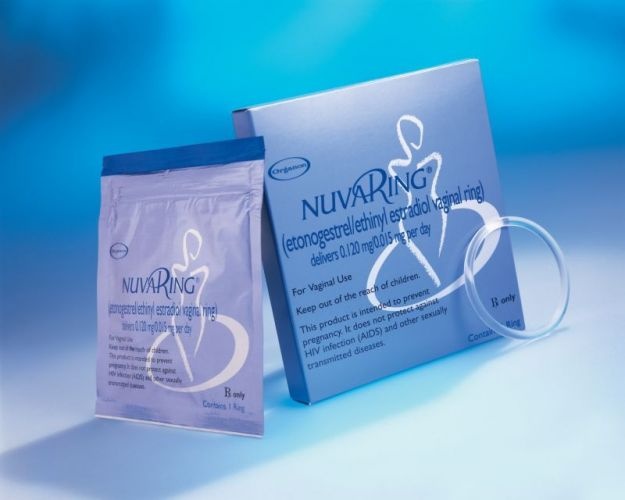
How to use Nuvaring
Leaflet accompanying the packaging: information for the user
Warning! Keep the leaflet! Information on the immediate packaging in a foreign language.
NuvaRing, (0.120 mg + 0.015 mg)/24 h, vaginal therapeutic system
Etonogestrel + Ethinylestradiol
Important information about combined hormonal contraceptives
- If used correctly, they are one of the most reliable, reversible methods of contraception.
- They slightly increase the risk of blood clots in veins and arteries, especially in the first year of use or after resuming use after a break of 4 weeks or more.
- Caution should be exercised and a doctor should be consulted if the patient suspects that symptoms of blood clots have occurred (see section 2 "Blood clots").
The leaflet should be read carefully before using the medicine, as it contains important information for the patient.
- The leaflet should be kept in case it needs to be re-read.
- In case of any doubts, a doctor or pharmacist should be consulted.
- This medicine has been prescribed to a specific person. It should not be given to others. The medicine may harm another person.
- If the patient experiences any side effects, including any side effects not listed in this leaflet, they should tell their doctor or pharmacist. See section 4.
Table of contents of the leaflet
- 1. What is NuvaRing and what is it used for
- 2. Important information before using NuvaRing
- 3. How to use NuvaRing
- 4. Possible side effects
- 5. How to store NuvaRing
- 6. Contents of the packaging and other information
1. What is NuvaRing and what is it used for
NuvaRing is a contraceptive in the form of a vaginal therapeutic system, preventing pregnancy. Each vaginal therapeutic system contains a small amount of two female sex hormones - etonogestrel and ethinylestradiol. These hormones are slowly released from the system into the bloodstream. Due to the small dose of hormones released, NuvaRing is classified as a low-hormone contraceptive. Since NuvaRing releases two different hormones, it is also a combined contraceptive.
2. Important information before using NuvaRing
General notes
Before starting to use NuvaRing, you should read the information about blood clots (thrombosis) in section 2. It is especially important to read about the symptoms of blood clots (see section 2 "Blood clots").
NuvaRing, like other hormonal contraceptives, does not protect against HIV infection (AIDS) or other sexually transmitted diseases.
2.1 When not to use NuvaRing
NuvaRing should not be used if the patient has any of the following conditions. If the patient has any of the following conditions, they must inform their doctor. The doctor will discuss with the patient which other contraceptive method will be more suitable.
- if the patient currently has (or has ever had) a blood clot in the veins of the legs (deep vein thrombosis), in the lungs (pulmonary embolism), or in other organs,
- if the patient knows they have a blood clotting disorder - such as protein C deficiency, protein S deficiency, antithrombin III deficiency, factor V Leiden, or antiphospholipid antibodies,
- if the patient needs to have surgery or will be immobilized for a long time (see section "Blood clots"),
- if the patient has had a heart attack or stroke,
- if the patient has (or has had in the past) angina pectoris (a disease that causes severe chest pain, which can be the first symptom of a heart attack) or a transient ischemic attack (temporary stroke symptoms),
- if the patient has any of the following diseases, which may increase the risk of a blood clot in an artery:
- severe diabetes with blood vessel damage
- very high blood pressure
- very high levels of fats in the blood (cholesterol or triglycerides)
- hyperhomocysteinemia
- if the patient has (or has had in the past) a type of migraine called "migraine with aura",
- if the patient has (or has had in the past) pancreatitis associated with high levels of fats in the blood,
- if the patient has (or has had in the past) severe liver disease, and liver function has not returned to normal,
- if the patient has (or has had in the past) a benign or malignant liver tumor,
- if the patient has (or has had in the past) breast cancer or genital organ cancer, or if there is a suspicion of these cancers,
- if the patient has unexplained vaginal bleeding,
- if the patient is allergic to ethinylestradiol or etonogestrel or any of the other ingredients of this medicine (listed in section 6).
If any of the above conditions occur for the first time while using NuvaRing, the system should be removed from the vagina and a doctor should be consulted immediately. A non-hormonal contraceptive method should be used during this time.
2.2 Warnings and precautions
When should a doctor be contacted?
- if the patient notices any symptoms that may indicate the occurrence of blood clots, which may indicate that the patient has blood clots in the leg (deep vein thrombosis), blood clots in the lungs (pulmonary embolism), a heart attack, or a stroke (see below "Blood clots").
The doctor should be told if the patient has any of the following conditions.
If these symptoms appear or worsen while using NuvaRing, the doctor should also be told.
- if breast cancer is present or has occurred in close relatives;
- if the patient has epilepsy (see section 2.4 "NuvaRing and other medicines");
- if the patient has liver disease (e.g., jaundice) or gallbladder disease (e.g., gallstones);
- if the patient has Crohn's disease or ulcerative colitis (chronic inflammatory bowel diseases);
- if the patient has systemic lupus erythematosus (a disease that affects the body's natural defense system);
- if the patient has hemolytic uremic syndrome (a blood clotting disorder that causes kidney failure);
- if the patient has sickle cell anemia (a genetic disorder of red blood cells);
- if the patient has been diagnosed with high levels of fats in the blood (hypertriglyceridemia) or has a family history of this disease. Hypertriglyceridemia is associated with an increased risk of developing pancreatitis;
- if the patient needs to have surgery or will be immobilized for a long time (see section 2 "Blood clots");
- if the patient has recently given birth, as they are at increased risk of blood clots. The doctor should be consulted to determine how soon NuvaRing can be started after giving birth;
- if the patient has superficial thrombophlebitis (inflammation of the veins under the skin);
- if the patient has varicose veins;
- if the patient has diseases that occurred for the first time or worsened during pregnancy or previous use of sex hormones (e.g., hearing loss, porphyria [a blood disorder], herpes gestationis [a blistering skin rash during pregnancy], or Sydenham's chorea [a neurological disorder characterized by involuntary, sudden movements of the body]),
- the doctor should be consulted immediately if symptoms of angioedema occur, such as swelling of the face, tongue, and/or throat, and/or difficulty swallowing or breathing. Estrogen-containing medications like NuvaRing may cause or worsen symptoms of hereditary and acquired angioedema;
- if the patient has chloasma (yellow-brown patches on the skin, especially on the face) now or in the past. If this occurs, excessive sun exposure and ultraviolet radiation should be avoided;
- if the patient has conditions that make it difficult to use NuvaRing, such as frequent constipation, uterine prolapse, or pain during intercourse;
- if the patient experiences sudden, frequent need to urinate with a burning sensation and/or pain, and/or if the patient cannot locate the vaginal ring inside the vagina. These symptoms may indicate that the vaginal ring has been accidentally inserted into the bladder.
wewnątrz pochwy. Powyższe objawy mogą wskazywać na przypadkowe umieszczenie systemu
terapeutycznego dopochwowego NuvaRing w pęcherzu moczowym.
BLOOD CLOTS
The use of combined hormonal contraceptives, such as NuvaRing, is associated with an increased risk of blood clots, compared to not using them. In rare cases, a blood clot can block a blood vessel and cause serious complications.
How to recognize the occurrence of blood clots
A doctor should be consulted immediately if any of the following symptoms are noticed.
- swelling of the leg or swelling along a vein in the leg or foot, especially if it is accompanied by:
- pain or tenderness in the leg, which may only be felt when standing or walking;
increased temperature in the affected leg;
- change in skin color of the leg, such as pallor, redness, or discoloration.
- sudden onset of unexplained shortness of breath or rapid breathing;
- sudden onset of coughing without an obvious cause, which may be accompanied by coughing up blood;
- sharp chest pain, which may worsen with deep breathing;
- severe dizziness or fainting;
- rapid or irregular heartbeat;
- severe abdominal pain.
If the patient is unsure, they should consult a doctor, as some of these symptoms, such as coughing or shortness of breath, may be mistaken for milder conditions, such as a respiratory infection (e.g., a cold).
BLOOD CLOTS IN VEINS
What can happen if blood clots form in veins?
- The use of combined hormonal contraceptives is associated with an increased risk of blood clots in veins (venous thromboembolism). Although these side effects are rare, they can occur. Most often, they occur in the first year of using combined hormonal contraceptives.
- If blood clots form in the veins of the leg or foot, it can lead to the development of deep vein thrombosis.
- If a blood clot moves from the leg to the lungs, it can cause a pulmonary embolism.
- In very rare cases, a blood clot can form in another organ, such as the eye (retinal vein thrombosis).
When is the risk of blood clots in veins highest?
The risk of blood clots in veins is highest during the first year of using combined hormonal contraceptives for the first time. The risk may also be higher when resuming the use of combined hormonal contraceptives (the same or a different medicine) after a break of 4 weeks or more.
What factors increase the risk of blood clots in veins?
The risk of blood clots associated with NuvaRing is small, but some factors can increase this risk. The risk is higher:
- if the patient is overweight (body mass index (BMI) over 30 kg/m^2);
- if someone in the patient's immediate family has had blood clots in the legs, lungs, or other organs at a young age (e.g., under 50 years old). In this case, the patient may have a genetic blood clotting disorder;
- if the patient needs to have surgery or will be immobilized for a long time due to injury or illness or has a leg in a cast. It may be necessary to stop using NuvaRing for a few weeks before surgery or immobilization. If the patient needs to stop using NuvaRing, they should ask their doctor when they can resume using it;
- with age (especially over 35 years old);
- if the patient has recently given birth.
The risk of blood clots increases with the number of risk factors present in the patient.
BLOOD CLOTS IN ARTERIES
What can happen if blood clots form in arteries?
Similarly to blood clots in veins, blood clots in arteries can cause serious complications, such as a heart attack or stroke.
Factors that increase the risk of blood clots in arteries
It is essential to note that the risk of a heart attack or stroke associated with NuvaRing is very small, but it may increase:
- with age (over approximately 35 years old);
- if the patient smokes. While using a hormonal contraceptive like NuvaRing, it is recommended to quit smoking. If the patient is unable to quit smoking and is over 35 years old, the doctor may recommend using a different type of contraception;
- if the patient is overweight;
- if the patient has high blood pressure;
- if someone in the patient's immediate family has had a heart attack or stroke at a young age (under 50 years old). In this case, the patient may also be at increased risk of having a heart attack or stroke;
- if the patient or someone in their immediate family has had high levels of fats in the blood (cholesterol or triglycerides);
- if the patient has migraines, especially migraines with aura;
- if the patient has heart disease (valve damage, arrhythmia called atrial fibrillation);
- if the patient has diabetes.
If the patient has more than one of the above conditions or if any of them are severe, the risk of blood clots may be even higher.
CANCER
The following information is based on studies using combined oral contraceptives and may also apply to NuvaRing. Information on vaginal use of hormonal contraceptives (as with NuvaRing) is not available.
Among women using combined contraceptives, breast cancer has been found to occur slightly more often, although it is not known if this is caused by the medicines. It is possible that women using combined contraceptives are more likely to have their breasts examined, which may lead to more cases of breast cancer being detected.
The increased frequency of breast cancer disappears gradually after stopping the use of combined contraceptives. Regular breast examination is very important. If a lump is found, a doctor should be consulted. The doctor should also be informed if breast cancer has occurred or is occurring in close relatives (see section 2.2 "Warnings and precautions").
In rare cases, women using combined contraceptives have been found to have benign liver tumors, and very rarely, malignant liver tumors. If severe, unusual abdominal pain occurs, a doctor should be consulted.
There are reports that women using combined contraceptives are less likely to have endometrial cancer (cancer of the lining of the uterus) and ovarian cancer. It is possible that this also applies to NuvaRing, but this has not been confirmed yet.
MENTAL HEALTH
Some women using hormonal contraceptives, including NuvaRing, have reported depression or mood swings. Depression can be severe and sometimes lead to suicidal thoughts. If mood changes and symptoms of depression occur, a doctor should be consulted as soon as possible for further medical advice.
2.3 Children and adolescents
The safety and efficacy of NuvaRing have not been studied in adolescents under the age of 18.
2.4 NuvaRing and other medicines
A doctor should always be informed about any medicines or herbal products being used. The doctor of another specialty or the dentist prescribing other medicines (or the pharmacist) should also be informed about the use of NuvaRing. They may inform about the need to use an additional contraceptive method (e.g., a condom) and, if so, for how long, as well as whether it is necessary to modify the use of another medicine.
- Some medicines may affect the level of NuvaRing in the blood;
- may reduce its contraceptive effectiveness;
- may cause unexpected bleeding.
This applies to medicines used to treat:
- epilepsy (e.g., primidone, phenytoin, barbiturates, carbamazepine, oxcarbazepine, topiramate, felbamate);
- tuberculosis (e.g., rifampicin);
- HIV infection (e.g., ritonavir, nelfinavir, nevirapine, efavirenz);
- hepatitis C virus infection (e.g., boceprevir, telaprevir);
- other infectious diseases (e.g., griseofulvin);
- high blood pressure in the blood vessels of the lungs (bosentan);
- depressive moods (St. John's Wort).
If the patient is taking medicines or herbal products that may reduce the effectiveness of NuvaRing, a mechanical contraceptive method (e.g., a condom) should also be used. Due to the fact that the effect of another medicine on NuvaRing may persist for up to 28 days after stopping the medicine, it is necessary to use additional mechanical contraception during this time.
NuvaRing should not be used with a diaphragm, cervical cap, or female condom.
NuvaRing may affect the action of other medicines, such as:
- cyclosporine
- the antiepileptic medicine lamotrigine (this may lead to an increased frequency of seizures).
If the patient has hepatitis C virus infection and is taking medicines containing ombitasvir, paritaprevir, ritonavir, and dasabuvir or glecaprevir, pibrentasvir, NuvaRing should not be used, as it may cause an increase in liver enzyme levels in blood tests.
Before starting these medicines, the doctor will prescribe a different type of contraceptive.
The use of NuvaRing can be resumed about 2 weeks after the end of this treatment. See section 2.1 "When not to use NuvaRing".
Before taking any medicine, a doctor or pharmacist should be consulted.
During the use of NuvaRing, tampons can be used at the same time. NuvaRing should be inserted before inserting a tampon. Care should be taken when removing a tampon to avoid accidentally removing NuvaRing as well. If NuvaRing is expelled, it can be rinsed with cold or lukewarm water and reinserted as soon as possible.
Damage to NuvaRing has occurred during the use of vaginal products, such as moisturizers or treatments for infections (see section 3.4, "What to do if NuvaRing is damaged"). The use of spermicides or vaginal antifungal medicines does not reduce the contraceptive effectiveness of NuvaRing.
Diagnostic tests
If laboratory tests of blood or urine are performed, the person performing the test should be informed about the use of NuvaRing, as the use of the vaginal ring may affect the results of some laboratory tests.
2.5 Pregnancy and breastfeeding
NuvaRing should not be used during pregnancy or if there is a suspicion that the woman is pregnant. If the patient becomes pregnant while using NuvaRing, the vaginal ring should be removed and a doctor should be consulted.
If the patient wants to stop using NuvaRing because they want to become pregnant, they should read the information in section 3.5 "What to do when the patient wants to stop using NuvaRing".
The use of NuvaRing is not recommended during breastfeeding. If the patient wants to use NuvaRing during breastfeeding, they should consult their doctor first.
2.6 Driving and using machines
NuvaRing does not affect the ability to drive or use machines.
3. How to use NuvaRing
NuvaRing can be inserted and removed by the patient themselves. The doctor will instruct when to start using NuvaRing. The vaginal ring should be inserted on the appropriate day of the cycle (see section 3.3 "When to insert the first NuvaRing") and left in place for 3 weeks in a row. The patient should regularly check if NuvaRing is in place in the vagina (e.g., before and after intercourse) to ensure contraceptive protection. After 3 weeks, the ring should be removed and a 1-week break taken. Usually, during this break, withdrawal bleeding occurs.
3.1 Inserting and removing NuvaRing
- 1. Before inserting the ring, the expiration date should be checked (see section 5 "How to store NuvaRing").
- 2. Before inserting or removing the ring, hands should be washed.
- 3. The most comfortable position for insertion should be chosen, e.g., standing with one leg raised, squatting, or lying down.
- 4. NuvaRing should be removed from the pouch.
- 5. Holding the ring between the thumb and index finger, it should be squeezed and inserted into the vagina (see Figures 1-4). Alternatively, the ring can be inserted using the NuvaRing Applicator (not included in the NuvaRing packaging). The NuvaRing Applicator may not be available in all countries. The correct position of NuvaRing is one in which it is not felt. If the ring is uncomfortable, its position should be gently adjusted (e.g., pushed slightly further into the vagina) until the patient feels comfortable. The position of the ring in the vagina does not affect its contraceptive effectiveness.
- 6. After 3 weeks, the ring should be removed from the vagina. This can be done by hooking the index finger under the edge of the ring or by grasping it with the index and middle fingers and pulling it out (Figure 5). If the patient is unable to remove the ring, they should consult their doctor.
- 7. The used ring should be disposed of with other household waste, preferably in a sealed pouch in which it was originally packaged. NuvaRing should not be flushed down the toilet.
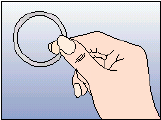
Figure 1
Remove the ring from the pouch
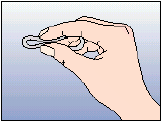
Figure 2
Squeeze the ring
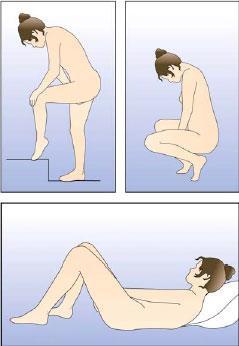
Figure 3
Choose the most comfortable position

Figure 4A
Figure 4B
Figure 4C
Insert the ring into the vagina with one hand (Figure 4A), if necessary, using the other hand to spread the labia. Place it inside the vagina so that it does not cause discomfort (Figure 4B). Leave the ring in the vagina for 3 weeks (Figure 4C).
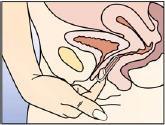
Figure 5
Remove the ring from the vagina, hooking the index finger under the edge of the ring or grasping it with the index and middle fingers and pulling it out.
3.2 Three weeks of use, one week of break
- 1. The ring must be in the vagina for 3 weeks without interruption, counting from the day of insertion.
- 2. After 3 weeks, it should be removed on the same day of the week it was inserted and at approximately the same time. For example, if NuvaRing was inserted on a Wednesday at around 10:00 PM, it should be removed on the Wednesday 3 weeks later at around 10:00 PM.
- 3. After removing the ring, a 1-week break should be taken. During this time, withdrawal bleeding may occur. It usually starts 2-3 days after removal.
- 4. A new ring should be inserted exactly 1 week after the break (on the same day of the week as usual and at approximately the same time), even if bleeding is still present. If the insertion of the new ring is delayed by more than 3 hours, its contraceptive effectiveness may be reduced. In such a case, the instructions in section 3.4 "What to do if the patient forgets to insert a new NuvaRing after the 1-week break" should be followed.
If NuvaRing is used according to the above instructions, subsequent bleedings will occur each month on approximately the same days of the week.
3.3 When to insert the first NuvaRing
- If no hormonal contraceptive was used in the previous cycle, NuvaRing should be inserted on the first day of the natural cycle (i.e., the first day of menstruation). NuvaRing is effective from the moment of insertion. There is no need to use any additional contraceptive methods. However, if NuvaRing is started between days 2 and 5 of menstruation, an additional contraceptive method (such as a condom) should be used during the first 7 days of NuvaRing use. This recommendation only applies to the first use of NuvaRing.
- If the patient used combined hormonal pills in the previous month, NuvaRing should be started no later than the day after the last active pill. If the previous pill pack also contains inactive pills, NuvaRing should be started no later than the day after the last inactive pill. If in doubt about which pill is which, the doctor or pharmacist should be consulted. The break in using the previous pills should not be extended beyond the recommended period. If the patient has been taking the pills regularly and is sure they are not pregnant, they can stop taking the pills on any day and start using NuvaRing immediately.
- If the patient used a transdermal patch in the previous month, NuvaRing should be started no later than the day after the patch is removed. The break in using the patch should not be extended beyond the recommended period. If the patient has been using the patch regularly and is sure they are not pregnant, they can stop using the patch on any day and start using NuvaRing immediately.
- If the patient used a minipill (progestin-only pill) in the previous month, they can stop taking the minipill on any day and start using NuvaRing the next day at the same time they would have taken the minipill. During the first 7 days of NuvaRing use, an additional contraceptive method (such as a condom) should be used.
- If the patient used injections or an implant, or an intrauterine system releasing progestin (IUD) in the previous month, NuvaRing should be started on the day of the next scheduled injection or on the day the implant or IUD is removed. During the first 7 days of NuvaRing use, an additional contraceptive method (such as a condom) should be used.
- After childbirth, the doctor may recommend using NuvaRing only after the first menstruation has occurred. Sometimes, NuvaRing can be started earlier; the doctor will advise when. If the patient is breastfeeding and wants to use NuvaRing, they should discuss this with their doctor first.
- After a miscarriage, according to the doctor's instructions.
3.4 What to do if…
What to do if the NuvaRing is accidentally expelled from the vagina
NuvaRing may be accidentally expelled from the vagina, e.g., if it was not inserted correctly, during tampon removal, during intercourse, due to constipation, or due to uterine prolapse. Therefore, the patient should regularly check if the ring is in place in the vagina (e.g., before and after intercourse).
3.5 Procedure when the patient wants to stop using NuvaRing
NuvaRing can be stopped at any time.
If the patient does not want to become pregnant, she should ask her doctor about other contraceptive methods.
If the patient stops using NuvaRing because she wants to become pregnant, she should wait until the first menstruation and then try to conceive. This will help determine the due date.
4. Possible side effects
Like all medicines, NuvaRing can cause side effects, although not everybody gets them. If any side effects occur, especially severe and persistent ones or changes in health that the patient considers related to the use of NuvaRing, the patient should consult a doctor.
All women using combined hormonal contraceptives have an increased risk of developing blood clots in the veins (venous thromboembolism) or blood clots in the arteries (arterial thrombosis). To obtain detailed information about the various risk factors associated with the use of combined hormonal contraceptives, the patient should refer to section 2 "Important information before using NuvaRing".
If there is an allergy (hypersensitivity) to any of the ingredients of NuvaRing, it may manifest as (frequency not known): angioedema and/or anaphylactic reaction [swelling of the face, lips, tongue, and/or throat and/or difficulty swallowing] or the occurrence of hives potentially with difficulty breathing. In these cases, NuvaRing should be removed and a doctor consulted immediately (see also section 2.2 "Warnings and precautions").
Women using NuvaRing have reported the following side effects:
Common:may occur in up to 1 in 10 women
- abdominal pain, nausea
- vaginal yeast infections (such as "thrush"); discomfort caused by the presence of the system in the vagina; genital itching; discharge
- headache or migraine; depressive mood; decreased libido
- breast pain; pelvic pain; painful menstruation
- acne
- weight gain
- expulsion of the system.
Uncommon: may occur in up to 1 in 100 women
- vision disturbances; dizziness
- bloating; vomiting, diarrhea, or constipation
- fatigue, malaise, or irritability; mood changes; sudden mood changes
- edema
- urinary tract infections
- problems or pain during urination; urgency or need to urinate; frequent urination
- discomfort during intercourse, including pain, bleeding, inconvenience related to the presence of the system, felt by the partner
- increased blood pressure
- increased appetite
- back pain; muscle cramps; pain in the lower or upper limbs
- decreased skin sensitivity
- breast tenderness or enlargement; fibrocystic breast disease (lumps that can cause swelling or pain in the breast)
- cervicitis; cervical polyps; cervical eversion
- changes in menstrual bleeding (e.g., heavy, prolonged, irregular, or complete absence of menstruation); pelvic discomfort; premenstrual syndrome; uterine cramps
- vaginal infections (fungal or bacterial); feeling of burning, unpleasant odor, pain, discomfort, or dryness of the vagina or vulva
- hair loss, rash, itching, or hives
- urticaria.
Rare: may occur in up to 1 in 1000 women
- harmful blood clots in a vein or artery, for example: in the leg or foot (e.g., deep vein thrombosis) in the lungs (e.g., pulmonary embolism) heart attack stroke transient ischemic attack or temporary stroke-like symptoms, known as a transient ischemic attack blood clots in the liver, stomach, and intestine, kidneys, or eye The risk of developing blood clots may be higher if the patient has other risk factors (see section 2 for more information on risk factors for blood clots and symptoms of blood clots).
- galactorrhea.
Unknown(frequency cannot be estimated from the available data)
- chloasma (brownish-yellow skin discoloration, especially on the face)
- partner's penis discomfort (such as irritation, rash, itching)
- inability to remove the therapeutic vaginal system without medical assistance (e.g., due to the therapeutic vaginal system adhering to the vaginal wall)
- vaginal wall damage related to damage to the therapeutic vaginal system.
Women using combined hormonal contraceptives have reported breast cancer and liver tumors. For more information, see section 2.2 "Warnings and precautions", "Tumors".
Very rarely, NuvaRing may be damaged. For more information, see section 3.4, "Procedure in case of damage to the therapeutic vaginal system".
Reporting side effects
If any side effects occur, including any side effects not listed in the leaflet, the patient should tell her doctor or pharmacist.
Side effects can be reported directly to the Department of Pharmacovigilance, Office for Registration of Medicinal Products, Medical Devices, and Biocidal Products, Al. Jerozolimskie 181C, 02-222 Warsaw, phone: +48 22 49 21 301, fax: +48 22 49 21 309, website: https://smz.ezdrowie.gov.pl .
Reporting side effects will help gather more information on the safety of the medicine.
5. How to store NuvaRing
The medicine should be stored out of sight and reach of children.
A doctor should be consulted in case of exposure of a child to the hormones contained in NuvaRing.
Store at a temperature below 30°C. Store in the original packaging to protect from light and moisture.
NuvaRing should not be used after 4 months from the date of issue of the medicine in the pharmacy. The date of issue is stated on the box and on the sachet.
NuvaRing should not be used after the expiry date stated on the packaging. The expiry date refers to the last day of the specified month.
NuvaRing should not be used if it has changed color or if there are any signs of deterioration.
The used therapeutic vaginal system should be disposed of in a regular household waste bin, preferably in a sealed sachet. NuvaRing should not be flushed down the toilet. Like other medicines, unused or expired systems should not be disposed of in the sewage system or household waste bins. The patient should ask her pharmacist how to dispose of medicines that are no longer needed. This will help protect the environment.
6. Package contents and other information
What NuvaRing contains
- The active substances of NuvaRing are: etonogestrel (11.7 mg) and ethinyl estradiol (2.7 mg).
- The other ingredients are: poly(ethylene-vinyl acetate), 28% and 9% vinyl acetate (a type of plastic that does not dissolve in the body), and magnesium stearate.
Etonogestrel and ethinyl estradiol are released from the therapeutic vaginal system at a rate of 0.120 mg/day and 0.015 mg/day, respectively, over a period of 3 weeks.
What NuvaRing looks like and what the package contains
NuvaRing is a flexible, transparent, colorless or almost colorless ring with an outer diameter of 54 mm.
Each therapeutic vaginal system is packaged in a separate foil sachet. The sachet can be reopened after opening. The sachets are placed in a cardboard box with the leaflet. The package contains 1 or 3 systems.
For more detailed information, the patient should contact the marketing authorization holder or the parallel importer.
Marketing authorization holder in Greece, the country of export:
N.V. Organon
Kloosterstraat 6
5349 AB Oss
Netherlands
Manufacturer:
N.V. Organon
Kloosterstraat 6
5349 AB Oss
Netherlands
Parallel importer:
InPharm Sp. z o.o.
ul. Strumykowa 28/11
03-138 Warsaw
Repackaged by:
InPharm Sp. z o.o. Services sp. k.
ul. Chełmżyńska 249
04-458 Warsaw
Marketing authorization number in Greece, the country of export:57201/1-9-2015
Parallel import authorization number: 76/23
This medicine is authorized in the Member States of the European Economic Area and in the United Kingdom (Northern Ireland) under the following names:
NuvaRing
0.120 mg/ 0.015 mg/ 24 h, therapeutic vaginal system
Austria, Belgium, Czech Republic, Denmark, Estonia, Finland, France, Germany, Greece, Hungary, Iceland, Ireland, Italy, Latvia, Lithuania, Luxembourg, Malta, Netherlands, Norway, Romania, Poland, Portugal, Slovakia, Slovenia, Spain, Sweden, United Kingdom (Northern Ireland).
Date of revision of the leaflet: 27.04.2023
These stickers, stuck on the corresponding day in the calendar, can help remember when to insert and remove NuvaRing.

Insert Remove
NuvaRing NuvaRing
[Information about the trademark]
- Country of registration
- Active substance
- Prescription requiredYes
- Marketing authorisation holder (MAH)N.V. Organon
- This information is for reference only and does not constitute medical advice. Always consult a licensed doctor before taking any medication. Oladoctor is not responsible for medical decisions based on this content.
- Alternatives to NuvaringDosage form: System, (0.12 mg + 0.015 mg)/24 hActive substance: vaginal ring with progestogen and estrogenPrescription requiredDosage form: System, (0.120 mg + 0.015 mg)/24 hActive substance: vaginal ring with progestogen and estrogenManufacturer: N.V. OrganonPrescription requiredDosage form: System, (0.12 mg + 0.015 mg)/24 hActive substance: vaginal ring with progestogen and estrogenPrescription required
Alternatives to Nuvaring in other countries
The best alternatives with the same active ingredient and therapeutic effect.
Alternative to Nuvaring in Ukraine
Alternative to Nuvaring in Spain
Online doctors for Nuvaring
Discuss dosage, side effects, interactions, contraindications, and prescription renewal for Nuvaring – subject to medical assessment and local rules.



